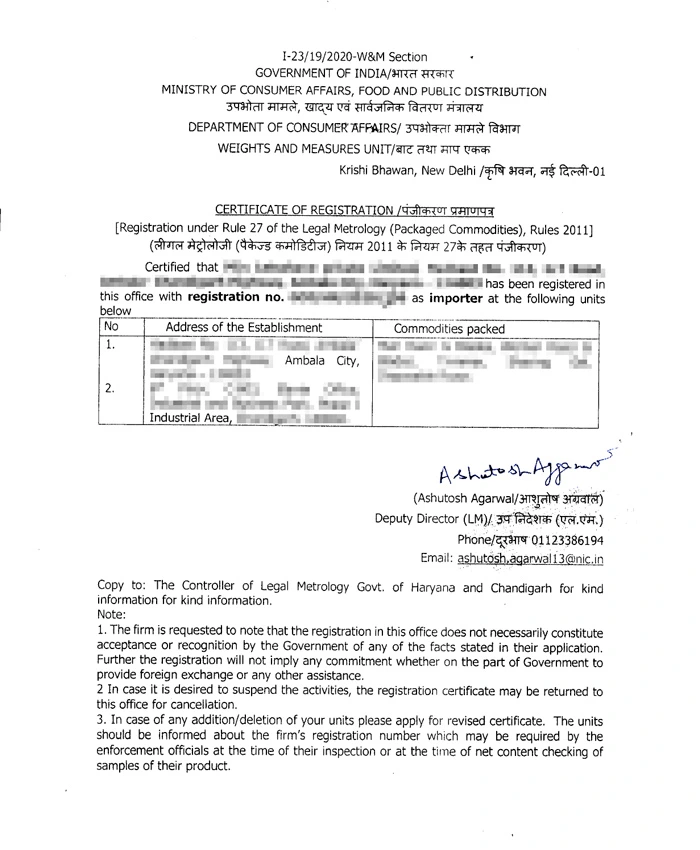
Updated on April 09, 2025 05:58:38 PM
The Legal Metrology Act of 2009 and the Legal Metrology (Packaged Commodities) Rules of 2011 create tight requirements for labeling and standardizing packaged commodities. The LMPC Certificate under Packaging & Labelling Law specifies the labeling standards for all manufactured, imported, and sold commodities, promoting transparency and consumer protection. This regulation covers a wide range of pre-packaged commodities, including food products such as dried fruits, ready-to-eat meals, drinks, jams, and processed fruits.
Every packaged commodity must have necessary statements such as the product's net amount, production date, maximum retail price (MRP), and country of origin (if imported). Compliance with the LMPC Certificate regulations supports fair commercial practices and shields customers from deceptive promises.
When a customer or citizen complains about labeling issues, a Legal Metrology Officer inspects wholesale and retail dealers. Failure to follow the Legal Metrology requirements may result in legal action, fines, or penalties. The LMPC Certificate under Packaging & Labelling Law restrictions are critical to preserving trade openness, providing consumers with accurate product information, and avoiding unfair corporate activities. Finally, the Legal Metrology Act seeks to promote uniformity, accountability, and consumer rights in commerce.

-.png)
Table of Content
Legal Metrology Packaging and labeling law is a system of laws and regulations that control how things are packaged, labeled, and sold in a certain nation or region. The LMPC Certificate under Packaging & Labelling Law promotes openness and consumer protection by requiring accurate product information. Important information such as product quality, quantity, price, production date, expiration date, and safety regulations must be clearly stated on the package. Compliance with these standards protects against misleading statements and supports fair trading practices. The LMPC Certificate rules assist customers make informed decisions by mandating standards, while also ensuring that firms use ethical packaging and labeling techniques to retain market credibility.

The following declaration needs to be mentioned on the label of the Pre-Packed Goods are -
Under Rule 6 sub-rule 4A importer, manufacturer or packer needs to have a declaration as mentioned below -


There are many rules and legislation for labelling and packaging of cosmetic products like The Drug & Cosmetics Rules 2020, ECO Labelling Standards by BIS, The Drugs & Cosmetics Act of 1940 and ECO Labelling Standards by BIS”.

Under the Department of Consumer Affairs, certain declarations need to be mentioned on any electronic goods for one year following that date, the product's package must include a QR code.

There may be a change in the pre-printed information on the package of the business entity mentioned below -

There are various products which are exempted are mentioned below -

Conclusion
The LMPC Certificate assures that producers follow legal metrology regulations to avoid penalties and conflicts. It requires compliance with packaging and labeling standards for pre-packaged items. Before awarding the dealer a LMPC Certificate under Packaging & Labelling Law, an authorized Legal Metrology inspector inspects the premises to ensure compliance. This accreditation contributes to the accuracy of weight, measurement, and labeling, assuring consumer protection and fair trade practices. Failure to follow LMPC Certificate under Packaging & Labelling Law may result in legal action, penalties, or limits on business activities. As a result, acquiring an LMPC certificate is critical for firms seeking to operate legally and preserve consumer trust.
At Professional Utilities, we leverage our industry knowledge and expertise to help businesses navigate complex regulations, minimize risks, and optimize operations for maximum efficiency and profitability.






Frequently Asked Questions
Labelling Policy is defined as the regulation that is issued to publish regulations mandating all "consumer commodities" to have labels that reveal their net contents, what they are, who makes them, and where they are made.
Packaging Rights are defined as the artwork and text used exclusively on the Products in the form sold at Completion, as well as all intellectual property rights that exist or are capable of existing in the packaging or get up in which the Products are now sold.
Packaging is defined as protecting the product from harm, contamination, and tampering during transport, storage, and sale, packaging ensures product safety.
Labelling is defined as supplying cautions, warnings, and guidelines for appropriate use. Labelling promotes safety by assisting consumers in avoiding potential hazards or inappropriate use of the product.
Speak Directly to our Expert Today

Reliable

Affordable

Assured